Beyond the Check Engine Light: Diagnosing Transmission Issues
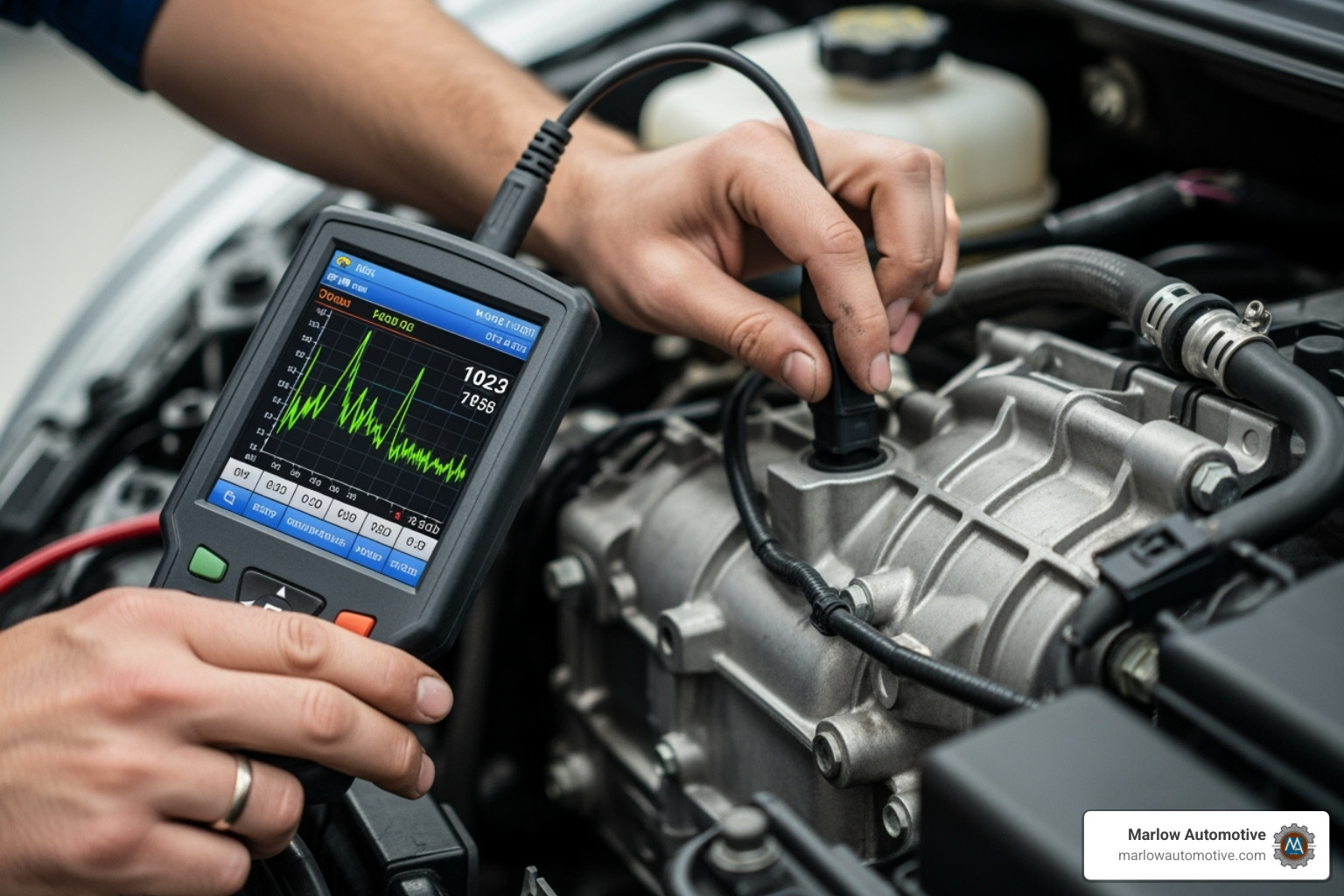
Why Transmission Diagnostics Are Critical for Your Vehicle
A transmission diagnostic is your vehicle's lifeline when something feels wrong with shifting, acceleration, or performance. Think of it as a complete health check-up for the heart of your drivetrain - the system that converts your engine's power into the torque that moves your wheels forward.
Quick Answer: Transmission diagnostics involve:
- Electronic scanning using OBD-II scanners to read error codes
- Visual inspection of fluid levels, leaks, and components
- Road testing to monitor real-time performance data
- Professional analysis by certified technicians
- Detailed reporting of findings and repair recommendations
The transmission is one of the most complex systems in your vehicle, second only to the engine itself. When issues arise, proper diagnosis becomes absolutely critical. Without it, as one transmission expert puts it, "fixing any transmission problem would be complete guess work."
Modern transmissions rely heavily on computer systems that regulate and monitor performance. This means diagnostic technology has evolved from purely mechanical inspections to sophisticated electronic processes. Today's technicians use state-of-the-art equipment to interface with your vehicle's onboard computer, retrieving specific diagnostic trouble codes that pinpoint exactly what's wrong.
Early detection through professional diagnostics can save you thousands. The goal is to identify issues - from minor adjustments to major repairs - before they become catastrophic problems that require complete transmission replacement.
Whether you're experiencing slipping gears, delayed shifting, strange noises, or that dreaded check engine light, understanding the diagnostic process helps you make informed decisions about your vehicle's care.
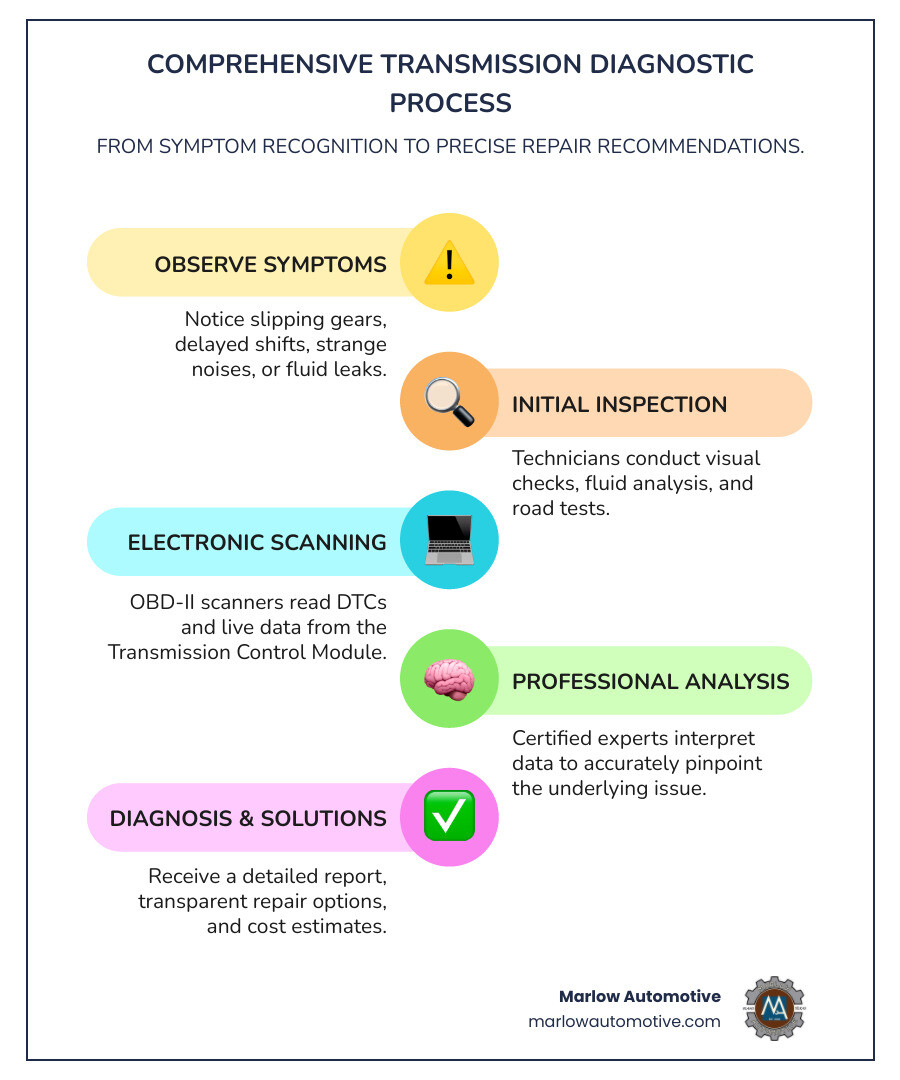
Warning Signs That Demand a Diagnostic Test
Your car is pretty good at telling you when something's wrong - you just need to know how to listen. Think of these warning signs as your transmission's way of asking for help before things get really expensive.
Slipping gears is one of the most common red flags. You'll feel your engine rev up, but your car doesn't accelerate like it should. It's like your transmission is playing catch-up instead of working smoothly with your engine. This happens when internal components start wearing down and can't maintain proper power transfer.
Delayed shifting is another telltale sign. When you shift from park into drive, does your car take a moment to "think about it" before engaging? Or maybe it shifts roughly when it finally decides to cooperate? These hesitations often point to issues with the transmission's control system or internal wear.
Erratic shifting can make your daily commute feel like a roller coaster ride. Your transmission might shift at weird times, skip gears, or jolt unexpectedly. This unpredictable behavior usually means the computer system controlling your transmission isn't getting the right information from sensors.
Fluid leaks are easy to spot if you know what to look for. Red fluid puddles under your parked car are a dead giveaway - transmission fluid has a distinctive reddish-pink color that's different from other automotive fluids. Even small leaks can quickly become big problems since your transmission needs that fluid to stay cool and lubricated.
A burning smell is your transmission's cry for help. This sweet or acrid odor means your transmission fluid is overheating, which destroys its ability to protect internal components. When fluid burns, it's like trying to run your transmission without proper lubrication.
Strange noises tell their own story. Whining sounds often point to pump or torque converter problems. Grinding usually means gears aren't meshing properly. Clunking can indicate worn mounts or internal damage. These sounds typically get worse over time, so early attention can save you major headaches.
Don't ignore your dashboard either. The Check Engine Light might seem generic, but it often relates to transmission issues. Some vehicles have dedicated transmission warning lights too. If any warning light appears, our Check Engine Light Service can help identify the root cause.
Common Symptoms of Transmission Problems:
- Slipping out of gear
- Delayed engagement or shifting
- Rough or hard shifts
- Burning smell
- Reddish-pink fluid leaks
- Whining, humming, grinding, or clunking noises
- Check Engine Light or Transmission Warning Light illuminated
- Vehicle hesitates or shakes during acceleration
- Failure to move when in gear
Checking Transmission Fluid
Your transmission fluid is like the blood in your veins - it needs to be clean, at the right level, and flowing properly. Checking it yourself is easier than you might think, and it can give you valuable clues about your transmission's health.
Start with your engine running and the transmission in park (check your owner's manual first - some manufacturers have specific requirements). The fluid level check involves locating your transmission dipstick, pulling it out, wiping it clean, then reinserting it completely before checking the reading.
Fluid color tells you a lot about what's happening inside your transmission. Healthy fluid looks bright red and clear. If it's dark brown or black, that's trouble. A milky appearance usually means water contamination, which can happen if your transmission cooler develops a leak.
Fluid smell is just as important as color. Fresh transmission fluid has a slightly sweet petroleum smell. A burnt odor means your fluid has been overheated and can't do its job properly anymore. Dark fluid combined with a burnt smell is a sure sign you need professional attention.
Low fluid level almost always means you have a leak somewhere. Your transmission is a sealed system, so fluid doesn't just disappear. Even small leaks can cause big problems because your transmission relies on precise hydraulic pressure to function.
For more information about maintaining your vehicle's vital fluids, check out our oil change services that keep your entire drivetrain healthy.
Noticing Performance Issues
Sometimes your transmission problems show up in how your car behaves on the road. These performance issues can be subtle at first, but they're important warning signs that shouldn't be ignored.
Hesitation when you put your car in gear is like your transmission saying "give me a minute." This delay often means internal clutch packs are wearing out or your valve body isn't directing fluid pressure properly. It might start as just a second or two, but it usually gets worse over time.
Shaking or vibrations during acceleration can come from several sources. Sometimes it's worn transmission mounts that aren't holding everything steady. Other times it's internal components that aren't working smoothly together anymore.
The worst-case scenario is when your vehicle won't move at all. You're in drive, you press the gas, but nothing happens. This could mean complete transmission failure, critically low fluid, or major internal damage. It's definitely time for immediate professional help.
Slipping out of gear is dangerous and frustrating. You're driving along normally when suddenly your car acts like it's in neutral. This can happen when internal components are so worn they can't maintain engagement.
Rough shifts feel like someone's kicking your car from behind every time it changes gears. Instead of smooth transitions, you get harsh jolts that can rattle your teeth. This usually points to problems with solenoids, fluid pressure, or worn internal parts.
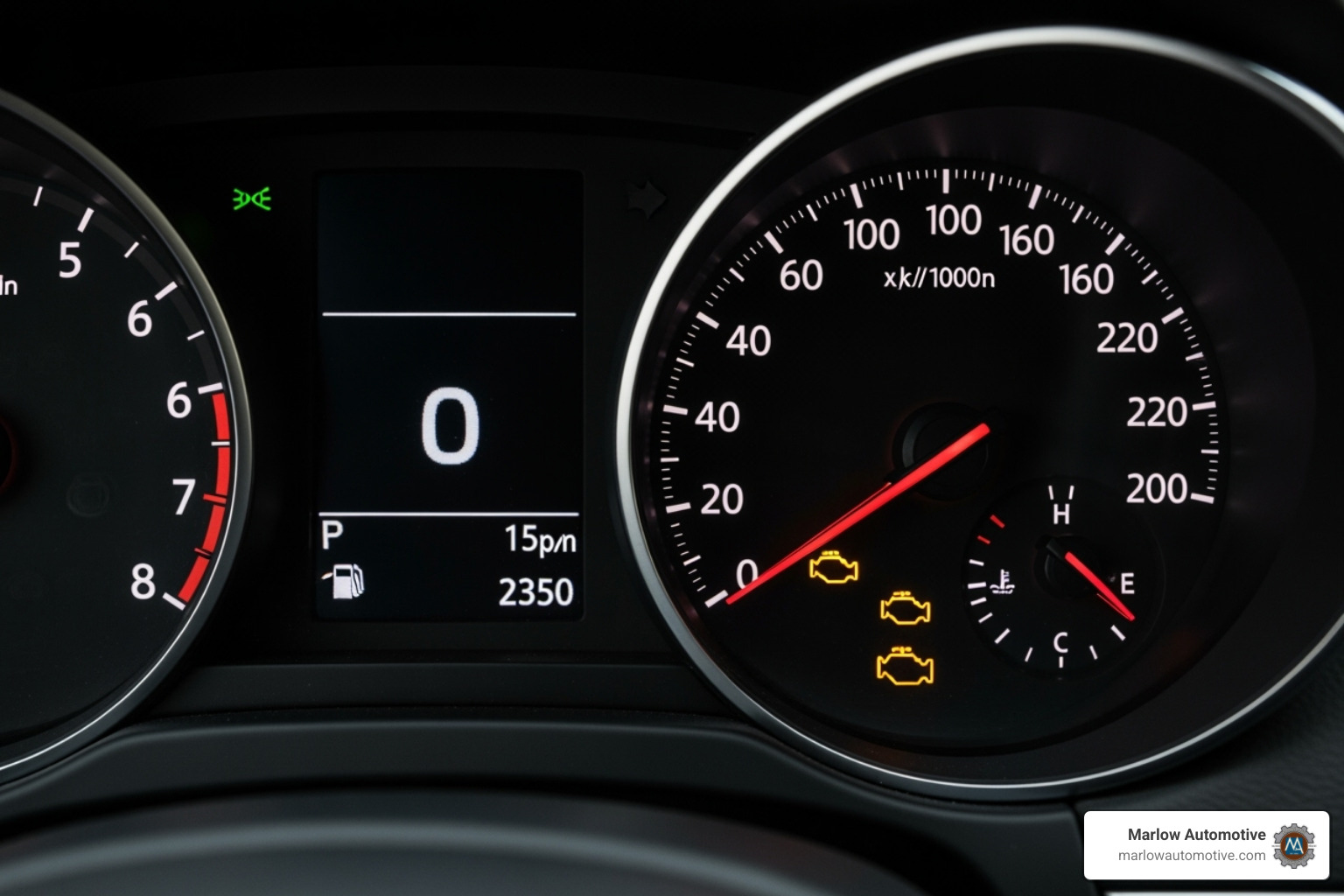
When you notice any of these symptoms - especially multiple ones together - it's time for a professional transmission diagnostic. Catching problems early can mean the difference between a relatively simple repair and a complete transmission rebuild.
The Comprehensive Transmission Diagnostic Process
When your transmission starts acting up, you need more than just guesswork. At Marlow Automotive, our transmission diagnostic process is like having a detective solve a mystery - we leave no stone unturned until we find the real culprit behind your vehicle's problems.
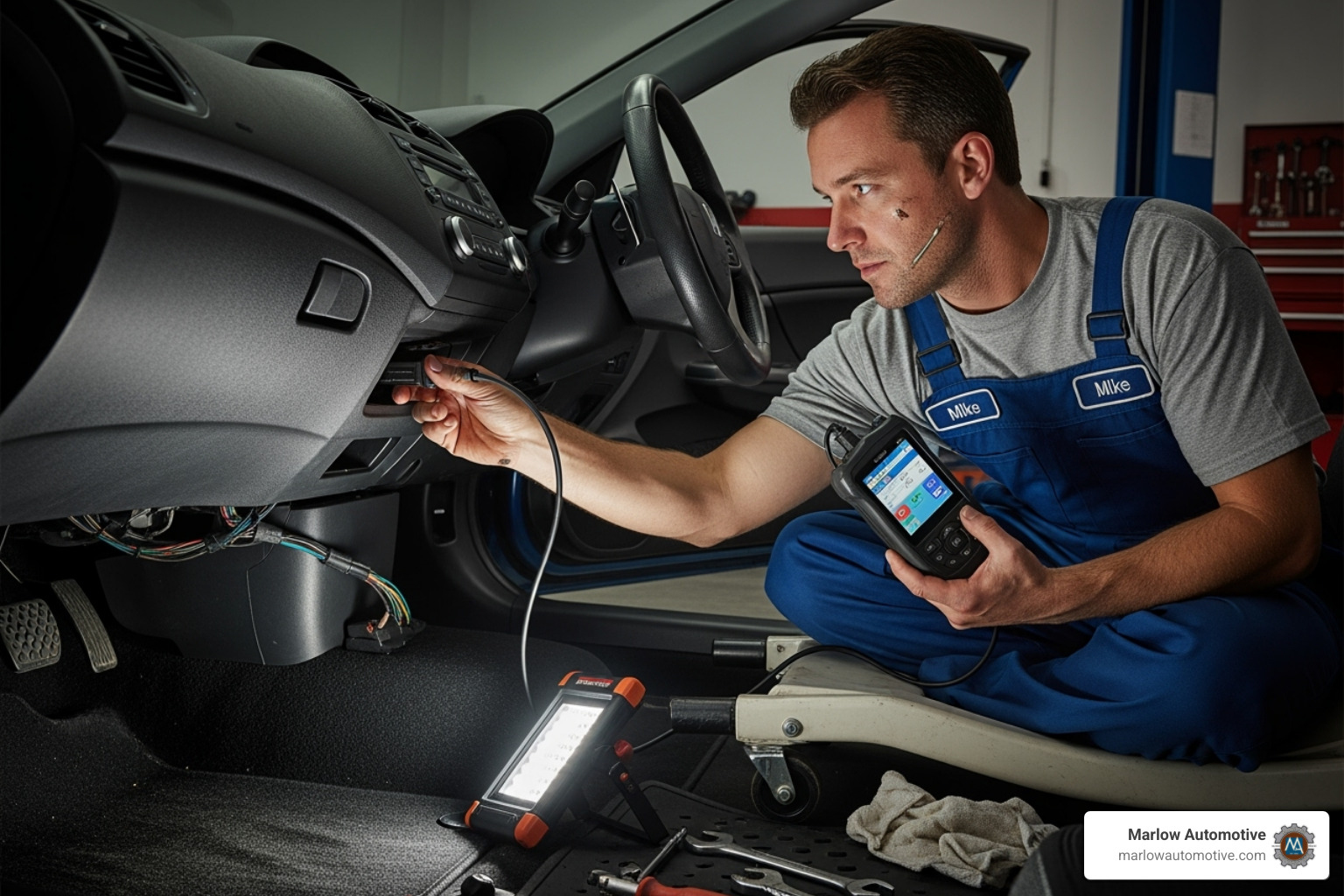
Think of it this way: your transmission is having a conversation with your car's computer system every second you drive. When something goes wrong, that conversation gets interrupted or distorted. Our job is to listen in on that conversation and figure out exactly what's being said.
Our ASE-certified technicians combine old-school hands-on experience with cutting-edge technology. It's this blend of human expertise and advanced tools that often gives you better results than you'd get at a dealership - and usually at a better price too.
We don't rush through diagnostics. Why? Because a thorough transmission diagnostic today can save you thousands of dollars tomorrow. It's really that simple.
The Initial Hands-On Inspection
Before we plug in any fancy computers, our technicians get their hands dirty with a good old-fashioned visual inspection. Sometimes the most obvious clues are hiding in plain sight.
First, we get your car up on the rack. This gives us a clear view of everything underneath. We're looking for the obvious troublemakers: fluid leaks around the pan gasket, worn seals on the input or output shafts, and any damage to the cooler lines that keep your transmission from overheating.
Red puddles under your car don't lie. If we find a leak, we trace it back to its source. Sometimes it's just a loose drain plug or worn gasket - an easy fix. Other times, it points to more serious internal wear.
We also check the transmission mounts. These rubber and metal supports keep your transmission properly positioned. When they wear out, you get vibrations, noise, and shifting problems that have nothing to do with what's inside the transmission itself.
Then comes the road test - and this isn't just a spin around the block. Our technician takes your car through its paces, monitoring how it behaves under different conditions. We're feeling for hesitation during shifts, listening for unusual noises, and watching how the transmission responds when we ask it to work harder.
During this drive, we're also watching live sensor data on our diagnostic equipment. Your car is constantly measuring things like input speed, output speed, fluid temperature, and throttle position. When these numbers don't add up, they tell us exactly where to look next.
Leveraging Technology for an Accurate Transmission Diagnostic
Here's where things get really interesting. Your car's computer system is like having a built-in witness to everything that happens in your transmission. The On-Board Diagnostics (OBD-II) system has been watching and recording since 1996, storing trouble codes whenever something goes wrong.
Our professional-grade diagnostic scanners go way beyond the basic code readers you might find at an auto parts store. We can actually have a two-way conversation with your Transmission Control Module (TCM) - the computer brain that controls your transmission.
This means we can watch live data streams while your transmission is working. We see things like solenoid activity, pressure readings, and temperature fluctuations in real time. It's like having x-ray vision into your transmission's operation.
We can also perform active tests. Want to know if a specific solenoid is working? We can command it to operate and measure its response. Curious about fluid pressure in a particular circuit? We can test that too. This level of precision helps us avoid the "parts cannon" approach - replacing components until something works.
Modern diagnostic technology has revolutionized transmission repair. Instead of tearing apart your transmission to find the problem, we can often pinpoint the exact issue before we even remove the first bolt. That saves you time, money, and unnecessary repairs.
What to Expect from a Professional Transmission Diagnostic Service
We believe in treating you the way we'd want to be treated if it was our car having problems. That means complete transparency from start to finish.
When you arrive, we listen. Your description of the symptoms often provides crucial clues that our equipment might miss. Does it only happen when the transmission is cold? Does it get worse in stop-and-go traffic? These details matter.
After our comprehensive diagnostic, we sit down and explain everything in plain English. No confusing technical jargon or mysterious recommendations. We show you the data, explain what it means, and walk you through your options.
You'll get a detailed written report that breaks down our findings. If we found trouble codes, we explain what they mean. If we finded leaks or worn components, we show you exactly where they are and how serious the problem is.
We present all your repair options - not just the most expensive one. Sometimes a simple fluid change and filter replacement can solve your problem. Other times, you might need more extensive work. We prioritize our recommendations so you can make informed decisions about your budget and timeline.
Quality is non-negotiable. We use the best parts available and back our work with a solid 2-year/24,000-mile warranty. When we fix something, it stays fixed.
Communication doesn't stop after the diagnosis. If we find additional issues during repairs, we call you immediately. No surprise charges or unauthorized work. Your approval comes first, always.
The bottom line? A proper transmission diagnostic takes the guesswork out of transmission repair. It's an investment that pays for itself by ensuring you get exactly the right fix the first time.
Decoding Diagnostic Trouble Codes (DTCs)
When your car's computer detects something amiss, it doesn't just shrug and stay silent. Instead, it speaks to us through a special language called Diagnostic Trouble Codes, or DTCs. Think of these codes as your vehicle's way of leaving breadcrumbs that lead our technicians directly to the problem during a transmission diagnostic.
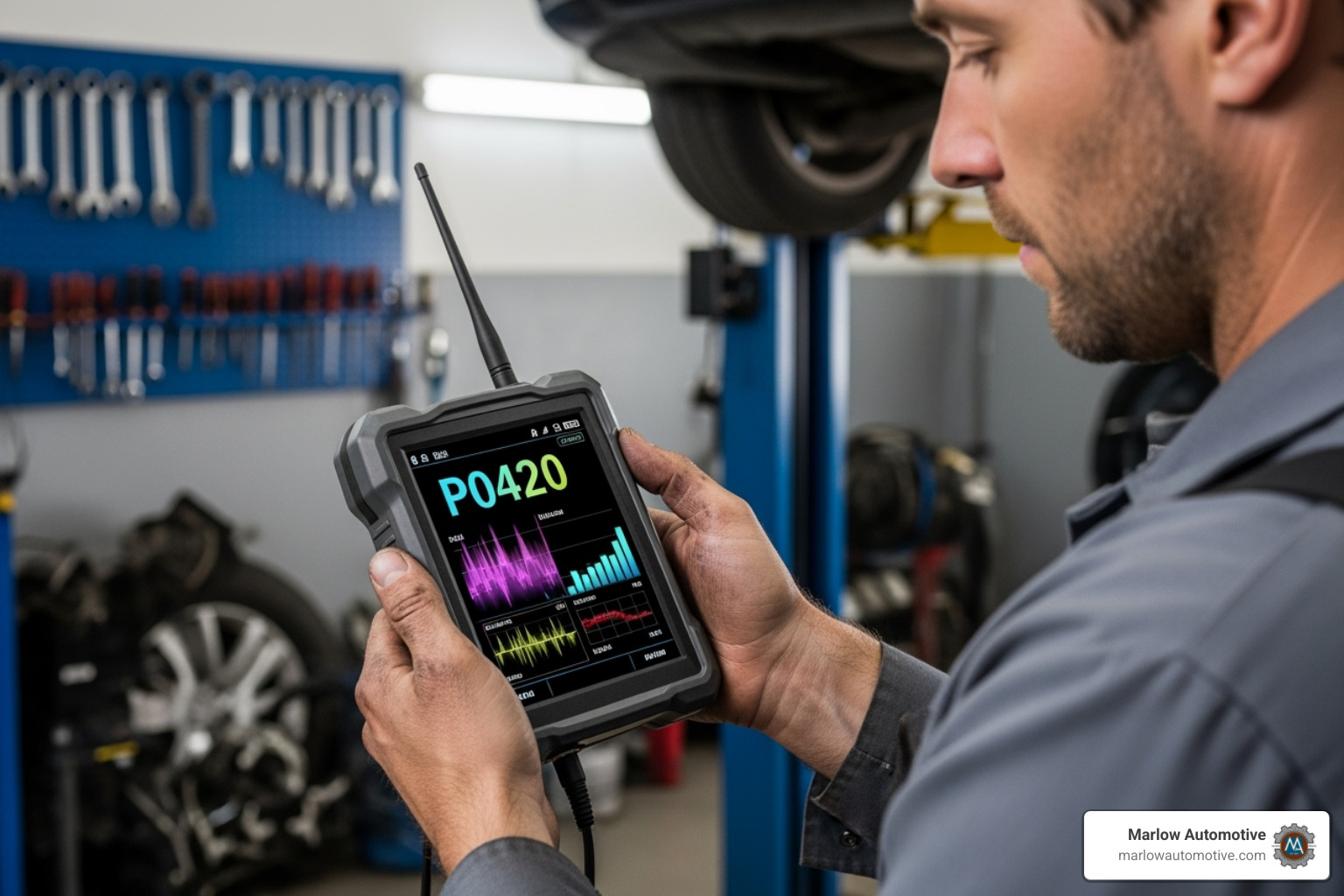
These alphanumeric codes are incredibly valuable tools that help us pinpoint exactly what's happening inside your transmission. When we connect our professional scanner to your vehicle's computer, we're essentially having a conversation with your car's brain. The codes we retrieve fall under what we call Powertrain codes or "P" codes - these relate specifically to your engine, transmission, and drivetrain systems.
Here's something interesting: if your vehicle is throwing codes that start with P06, P07, or P09, it's almost certainly telling us about a transmission or gearbox issue. These codes can reveal everything from minor sensor malfunctions to major internal problems, helping us determine whether you need a simple adjustment or more comprehensive repairs.
The beauty of this system is that it takes much of the guesswork out of diagnosis. Instead of having to tear apart your transmission to see what's wrong, we can often identify the problem area before we even get our hands dirty. When we do find issues that need attention, we're fully equipped to handle comprehensive Transmission Repair Services.
Global vs. Manufacturer-Specific Codes
Not all diagnostic codes are created equal, and understanding this difference is crucial for getting an accurate diagnosis. It's a bit like the difference between speaking basic English that everyone understands versus using technical jargon specific to your profession.
Global codes are the universal language of automotive diagnostics. These standardized codes begin with "P0" and mean the same thing whether you're driving a Ford, Toyota, or any other brand. They're designed to indicate general system malfunctions that any qualified technician should be able to understand and address.
Manufacturer-specific codes are where things get more interesting and detailed. These codes typically start with "P1" and provide much more precise information about what's happening in your particular make and model. While they still relate to powertrain issues, their exact meaning can vary significantly between manufacturers.
| Code Structure | Type of Code | Example | Meaning |
|---|---|---|---|
| P0xxxx | Global (Standardized) | P0700 | Transmission Control System Malfunction (general) |
| P1xxxx | Manufacturer-Specific | P1700 | Specific manufacturer transmission fault (e.g., Ford: Transmission Indeterminate Failure) |
This is why experience matters so much in transmission diagnostics. While a generic code reader might tell you there's a problem, our ASE-certified technicians know how to interpret both types of codes and understand the nuances that can make all the difference in an accurate diagnosis.
Common Transmission-Related "P" Codes
While there are literally hundreds of potential diagnostic codes, some show up more frequently than others when we're dealing with transmission issues. Understanding what these common codes mean can help you better grasp what might be happening with your vehicle.
P0700 is often the first code we see - it's like your transmission's way of waving a red flag. This Transmission Control System Malfunction code is essentially your car saying "Hey, something's not right back here!" It's usually accompanied by more specific codes that tell us exactly what the problem is.
P0732 and similar codes in the P0729-P0736 range indicate incorrect gear ratio problems. When we see P0732, for example, it means your transmission didn't shift into second gear properly. This could be due to low fluid levels, a failing clutch pack, or a malfunctioning solenoid. These codes are particularly helpful because they tell us exactly which gear is having trouble.
P0218 is one we take very seriously - it indicates your transmission is overheating. This can happen due to low fluid levels, blocked cooler lines, or a failing cooling fan. Since heat is one of the biggest enemies of transmission longevity, we address these codes immediately.
P0613 points to a problem within the Transmission Control Module itself. This could be anything from a loose electrical connection to an internal programming error. Sometimes it's a simple fix, other times it requires module replacement or reprogramming.
P0715 relates to your Input Speed Sensor, which monitors how fast the transmission's input shaft is spinning. When this sensor malfunctions, you might experience erratic shifting or find your transmission stuck in "limp mode" - a safety feature that keeps you moving but limits performance.
P0750 through P0770 codes typically indicate problems with shift solenoids - the small electronic components that control fluid flow to enable gear changes. Each solenoid controls specific gears, so these codes help us zero in on exactly which component needs attention.
While these codes are incredibly helpful, they tell us what your car's computer thinks is wrong, not necessarily why it's wrong. That's where our technicians' experience and additional testing come into play. We use these codes as starting points for deeper investigation, ensuring we address the root cause rather than just the symptoms.
For more comprehensive information about transmission and drivetrain issues, including how these codes relate to other system problems, visit our page on More on Drivetrain Issues.
Proactive Care: How Regular Maintenance Prevents Major Issues
While a transmission diagnostic is essential when problems arise, the best approach is always prevention. Think of it like going to the doctor for regular check-ups instead of waiting until you're really sick. Regular transmission maintenance can save you thousands of dollars and help you avoid those stressful moments when your car won't shift properly.

Following your manufacturer's service schedule is the foundation of transmission health. Your owner's manual isn't just light reading - it contains the exact intervals your transmission needs attention. Most vehicles benefit from transmission service every two years or between 40,000 and 50,000 miles, but your specific car might be different. When in doubt, give us a call at Marlow Automotive, and we'll help you figure out what's best for your vehicle.
Transmission fluid flush and filter changes are the heart of preventative maintenance. Over time, your transmission fluid breaks down from heat and picks up tiny metal particles from normal wear. It's like motor oil, but even more critical because your transmission depends on clean fluid for both lubrication and hydraulic pressure.
Here's something that might surprise you: once transmission fluid gets hotter than 200 degrees, its life drops dramatically. If you tow a trailer or drive in stop-and-go traffic regularly, your transmission works even harder. Fresh fluid can handle the heat much better than old, degraded fluid.
Your cooling system plays a bigger role than you might think. When your engine overheats, your transmission suffers too. The two systems are connected, and keeping your radiator, hoses, and coolant in good shape helps prevent transmission overheating. It's all connected - that's why we take a comprehensive approach to vehicle care.
Regular fluid checks between services can catch problems early. Remember those fluid inspection tips we covered earlier? Checking your transmission fluid every few months takes just a few minutes but can alert you to leaks or contamination before they become expensive problems.
At Marlow Automotive, we believe in taking care of all your vehicle's vital systems. Just like our Brake Fluid Flush Service keeps your brakes working safely, proper transmission maintenance keeps you moving smoothly down the road.
Avoiding overheating is crucial for extending transmission life. This means more than just watching your engine temperature gauge. It means ensuring your transmission cooler lines are clean, your radiator is functioning properly, and your transmission fluid is fresh enough to do its job.
The small investment you make in preventative maintenance today can prevent the need for a transmission diagnostic tomorrow - or worse, a complete transmission replacement. We've seen too many customers who could have saved thousands with regular maintenance. Don't let that be you.
For a complete picture of how we can help keep your vehicle running smoothly, check out our All Maintenance Services. Your transmission will thank you, and so will your wallet.
Your Next Steps for a Healthy Transmission
Your transmission works tirelessly behind the scenes, converting engine power into the smooth acceleration you depend on every day. After learning about the warning signs, diagnostic processes, and preventative care options, you might be wondering: "What should I do next?"
The answer is simpler than you think. Early detection is your best friend when it comes to transmission health. Those subtle hints your car gives you – that slight hesitation when shifting, the faint whining sound, or even just a feeling that something isn't quite right – are worth investigating. Ignoring them won't make them go away, but addressing them early can save you thousands of dollars.
Professional expertise makes all the difference. Modern transmissions are incredibly complex systems that require specialized knowledge and equipment to diagnose accurately. What might seem like a minor issue could actually be a symptom of something more significant, or conversely, what feels like a major problem might have a simple solution.
At Marlow Automotive, we've built our reputation on doing things the right way. Our ASE-certified technicians don't just run codes and guess – they perform comprehensive transmission diagnostics using the latest technology combined with decades of hands-on experience. We believe in treating your vehicle like it's our own, which means honest assessments and transparent communication every step of the way.
Quality parts and expert workmanship aren't luxuries – they're necessities when it comes to transmission repair. We use only the best components available, often exceeding what you'd find at a dealership. Our 2-year/24,000-mile warranty isn't just a promise; it's our commitment to standing behind every repair we make.
Located in Plano, TX, we serve drivers throughout the area who value reliability and honest service. Whether you need a simple diagnostic check, routine maintenance, or major transmission work, we keep you informed throughout the entire process. No surprises, no pressure – just straightforward solutions custom to your needs and budget.
Don't wait until a small problem becomes a big headache. Your transmission's health affects everything from fuel economy to safety, and addressing concerns promptly protects both your wallet and your peace of mind.
Ready to give your transmission the care it deserves? Schedule Your Transmission Service in Plano, TX with Marlow Automotive today. We're here to keep you moving forward with confidence.
Customer Testimonials
Service Areas







